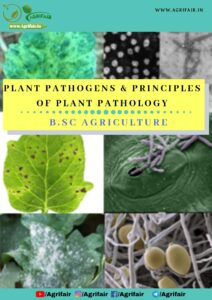Plant Pathogens and Principles of Plant Pathology pdf
Download free pdf of the book of Plant Pathogens and Principles of Plant Pathology.

Book Detail: Plant Pathogens and Principles of Plant Pathology
Language: English
Pages: 376
Author: TNAU
Click  to download pdf book
to download pdf book
Contents
01.Introduction5-11
02.Important plant pathogenic organisms- different groups- fungi, bacteria, fastidious vesicular bacteria, phytoplasmas, spiroplasmas, viruses, viriods, algae, protozoa and phanerogamic parasites with examples of diseases caused by them.12-19
03.General Characters of fungi- Definition of fungus, somatic structures, types of fungal thalli, fungal tissues, and modifications of thallus, reproduction in fungi (asexual and sexual).20-54
04.Nomenclature-Binomial system of nomenclature, rules of nomenclature, classification of fungi. Key to divisions and sub-divisions.55-56
05.Division I: Myxomycota, Class: Plasmodiophoromycetes, Order: Plasmodiophorales, Division II: Eumycota57-59
06.Subdivision: Mastigomycotina, class: Chytridiomycetes (Chytridiales), Oomycetes(Peronosporales).60-74
07.Subdivision: Zygomycotina (Mucorales),75-77
08.Subdivision: Ascomycotina, class: Hemiascomycetes (Taphrinales),class: Plectomycetes (Eurotiales), class: Pyrenomycetes (Erysiphales, Clavicepitales), class: Loculoascomycetes (Pleosporales),78-89
09.Subdivition: Basidiomycotina, class: Teliomycetes (Uredinales,Ustilaginales) class: Hymenomycetes (Aphyllophorales)90-110
10.Subdivition: Deuteromycotina: class: Coelomycetes (Sphaeropsidales), class: Hyphomycetes (Hyphomycetales, Agonomycetales).111-135
11.Prokaryotes: classification of prokaryotes according to Bergey’s Manual of Systematic Bacteriology. General characteristics of bacteria and examples of phytopathogenic bacteria, fastidious vesicularbacteria, phytoplasmas and spiroplasmas.136-141
12.Plant viruses-general characteristics and examples of plant diseases caused by viruses.142-151
13.Viroids- general characteristics and examples of diseases caused byviroids.152-155
14.Definition and objectives of Plant Pathology. History of PlantPathology.156-162
15.Terms and concepts in Plant Pathology. Survival and Dispersal ofPlantPathogens.163-199
16.Phenomenon of infection – pre-penetration, penetration andpostpenetration.200-204
17.Pathogenesis – Role of enzymes, toxins, growth regulators andpolysaccharides.205-211
18.Defense mechanism in plants – Structural and Bio-chemical (pre andpost-infection).212-223
19.Plant disease epidemiology – Meaning and importance, difference between simple and compound interest diseases – Factors affecting plant disease epidemics – host, pathogen, environment and time factor.224-234
20.Plant Disease Forecasting – Meaning, advantages, methods in forecasting and examples.235-241
21.Remote sensing – Meaning, scope, objectives,advantages.242-248
22.General principles of plant diseases management – Importance, general Principles – Avoidance, exclusion, eradication, protection andtherapy,immunization.249-252
23.Regulatory methods – Plant Quarantine and Inspection – Quarantine Rules and Regulations.253-273
24.Cultural methods – Rougeing, eradication of alternate and collateral hosts, crop rotation, manure and fertilizer management, mixed cropping, sanitation, hot weather ploughing, soil amendments, time of sowing ,seed rate and plant density, irrigation and drainage.274-294
25.Biological control and PGPR – Scope and importance – Role and mechanisms of biological control and PGPR with examples. Plantgrowth promoting rhizobacteria.295-305
26.Physical Methods – Heat treatments, soil solarization, hot water treatment, hot air treatment, control by refrigeration and radiation.306-308
27.Chemical methods – study of different groups of fungicides. Methods of application of fungicides.309-344
28.Host plant resistance – Importance – disease resistance, tolerance, susceptibility and disease escape. Horizontal and vertical resistance – Method of management of resistance. Immunization – Systemicacquiredresistance.345-354
29.Application of biotechnology in plant disease management–Importance, production of pathogen free plants through tissue culture techniques.355-358
30.Development of disease resistant treansgenic plants throughgenecloning.359-365
31.Integrated plant disease management (IDM) – Concept, advantagesandimportance.366-373
